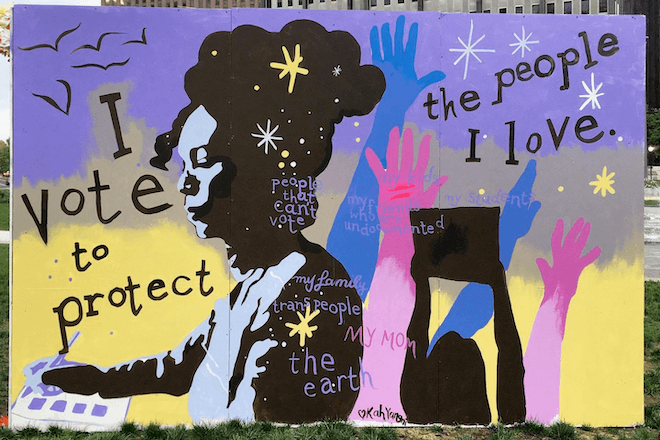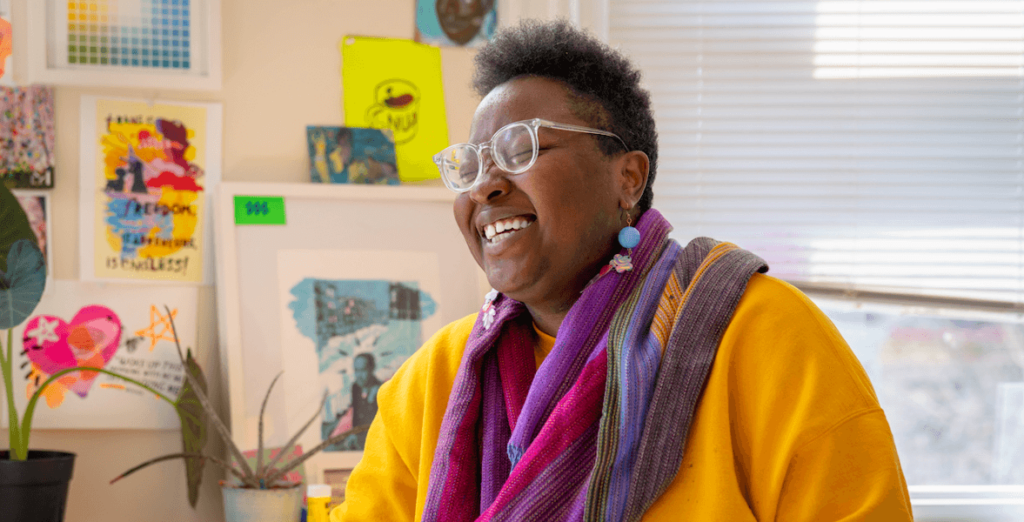The anthropologist David Graeber wrote that “direct action is, ultimately, the defiant insistence on acting as if one is already free.” Graeber’s idea encapsulates Kah Yangni’s practice, which spans murals to Skittles packaging to magazine illustrations. Whatever the medium, Yangni operates on the assumption that we live in a society where historically oppressed people — queer and trans people — are living their best lives unimpeded by individuals or governments. What makes Yangni’s work so compelling is that, of course, we live in an imperfect world — and the moments that they portray as ordinary may actually be the outliers.
Although Yangni graduated from Brown University with a degree in American Studies, a chance opportunity to learn screen printing led to their pursuit of illustration, printmaking, and muralism. Yangni’s big break came in 2019 when they designed a poster for the Trans Day of Resilience, an annual campaign celebrating the lives and futures of trans people. The poster declared “Trans is freedom, is adventure, is endless!” and marked a shift in their practice towards radical optimism, something that is not always well-received outside of the queer community.
Shortly after speaking with Yangni for this article, I was directly confronted with that tension. In a meeting with representatives from an iconic Philadelphia brand, I suggested Yangni as one of a dozen potential artists that they might hire for an upcoming project. Even after it became clear that other artists in the proposal would be a better fit, the company’s representatives felt the need to explicitly reject Yangni’s depictions of joyful trans people as being too “political” and “divisive” for their brand. And so here we are, speaking with an artist about making “Art for Change,” because they dare to act as though trans people are allowed to assert their existence in this city and world.

RJ Rushmore: What brought you to Philadelphia, and what keeps you here?
Kah Yangni: I wanted to make murals. I moved to Philly for the summer in 2017 to do the Mural Arts internship, where I worked with Dave McShane. I left, but I immediately wanted to come back. When I got the money, I moved here permanently in 2019. I’ve stayed because it’s really fun and inspiring. I even made my sister move here from the Bay. There is something about the size of the city and how much opportunity there is for artists in combination with it not being pretentious just made my practice get way bigger. I felt really free.
Free, how?
Seeing people, like the people I did the Mural Arts internship with, doing wild art stuff all the time makes me feel like I can do things too. Art is what brought me to Philadelphia, and this city is providing me and the people around me with opportunities. And then I hear people complain, “It’s so hard in Philly.” I don’t get that at all. I think it’s amazing here.
Don’t get me started on Philly artists who complain about a lack of opportunities.
What we have here is unusual. Push things to get better, but also recognize that full-time muralist is not a job in most places, so the fact that we have something approaching that is special. It’s weird. When I go to other places, people say, “We look at Philly as the model.” I went to Cincinnati last year. They were like, “We’re trying to copy everything y’all are doing.”
There’s a lot we can learn from how Cincinnati approaches public art, and I love that they are looking to Philly too.
Cincy is actually great! Similar underdog city vibes, and they work with some fantastic artists. But I’m also very inspired by the people around me here. When I was making a mural, my first large permanent project in Philadelphia, we painted it inside a studio at Bok. There is so much energy and inspiration in that building. Sammy Kovnat. Nicole Nikolich from Lace In The Moon. Conrad Benner from Streets Dept. Symone Salib.
Where I was before Philadelphia, I had queer friends doing queer DIY art projects for small audiences, but nobody was getting serious financial or institutional support. Coming here cleared a major mental block that someone like me can’t do big stuff. Now, all I see is people succeeding and working and pushing themselves. Everywhere you go, there’s a Ginger Rudolph or Nazeer Sabree. It shouldn’t be unusual to see people like that thriving, but it is. I had never lived in a place like that, until now. I feel like there’s no limits on what I can do. Everyone here wants you to push yourself all the way. It’s inspiring.
So much of what you make for public consumption, not just gallery walls. Murals, posters, billboards, book covers, et cetera. How do you approach working in public?
I first got excited about public art because the universe of people who have the same ideas as I do, or my friends do, mostly existed in communities that developed online. I was interested in putting our perspective out in the world on equal footing as other perspectives. In school, they make you say the Pledge of Allegiance every morning and those ideas are drilled into your head. Why not “trans is freedom” too? I want to see ideas like that taking up physical space, so that people confront them in real life. That has value. That has meaning.
You’re insisting people should be confronted with these ideas.
Exactly. I want shit to be different, I just do. I’m going to force it, so that’s what I’m doing. And other people also want to force the opposing perspective. So, we’ll try. We’ll put up murals, and other people will push back on that. When I painted the We Are Universal mural in Fishtown; that got transphobic comments on Instagram. That kind of pushback had not happened to me before.
When I make the posters celebrating trans people, those wind up in queer community spaces or published in queer magazines. For the most part, those are seen by people who already support the message. My murals and billboards are in public, seen by everyone. I feel like I’m part of a bigger movement to make there be room for queers and room for Black and Brown people to live. There are artists like me, but also writers and thinkers and teachers and just people out in the world claiming space. I don’t know if I want to say it’s been fun, but it makes everything I do feel like an experiment.
We should have more public art that people disagree about.
That’s where I want to be working.
You have a children’s book coming out in a few months.
Yes. It is written by this person named A.M. Wild, it’s called Not He or She, I’m Me. It’s just a book about a day in the life of a non-binary kid hanging out with their mom and their friends and being loved. It’s really sweet. It goes on sale October 17, but you can pre-order it now. I am excited.
You are quite selective in the design and illustration projects that you take on. When I see your posters, I can’t always tell right away if what you’ve made is a “personal project” or something for a client. It all blends together so well. How do you approach design or illustration projects?
I choose the projects that allow me to make what I would be making anyway. I wouldn’t normally be doing a candy packaging job, but I’ll take the Skittles job about making queer art. This comes into my personal projects too. I’m not going to make art just because. I have my topics that I care about. If the client is not hardcore evil, I’m just doing what I want to be doing anyway and my art gets to go out into the world.
When a job does not have too many constraints, there’s a lot of room for me to do what I would already be doing. That said, I also know my own limitations, and what is exciting to me. I don’t take that many projects where there are 10 things I have to hit. To me, that’s a graphic design project. The tricky area is, you get hired based on what you’ve done in the past, which makes it difficult to evolve. I created a lot of personal work from the time I graduated college until about 2020, and that’s what people have been responding to when they approach me with jobs. It’s probably time to start making my own work again, so that the commissions I get will be in response to the new things I make on my own. It’s time to reset the kinds of things I get approached to do.
That is a clever plan.
All illustrators know, you get jobs doing what you’re already doing. I was already making queer art, so then all the people that want to say stuff about that, they come to me, and it feels very natural. But now I’m older, time has passed, we’re in a really different moment with all that stuff, so now I need to do the same thing again. And then that will naturally bring the people to me that I’m meant to work with in the future. And hopefully also money.
Do you think you want to put the queer stories behind, or just change how you present them?
I think it’s gotten to a point where you feel sometimes like you’re selling who you are in a way that’s weird. I see people stepping away from the most intense forms of identity politics. I’m ready for a more natural version of talking about all these topics. I’m still figuring out how to do it and I see other people also figuring it out, but I’m psyched about it.
And maybe what you’re going to discover as you take this step back and do some of this personal work is how can you expand that message or tell that message in a way that is less rooted in performing identity. And then you’ll get gigs for things that are less rooted in identity.
Yeah. You’re onto something.
I’m not onto anything. I’m just taking your words and putting them in a different order. I think that means you’re onto something.
RJ Rushmore is a writer, curator and public art advocate. He is the founder of the street art blog Vandalog and culture-jamming campaign Art in Ad Places. As a curator, he has collaborated with Poster House, Mural Arts Philadelphia, The L.I.S.A. Project NYC and Haverford College. Rushmore’s writing has appeared in Hyperallergic, Juxtapoz, Complex and numerous books. He holds a B.A. in Political Science from Haverford College, where his thesis investigated controversies in public art.

